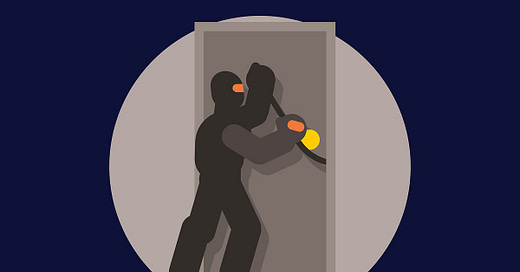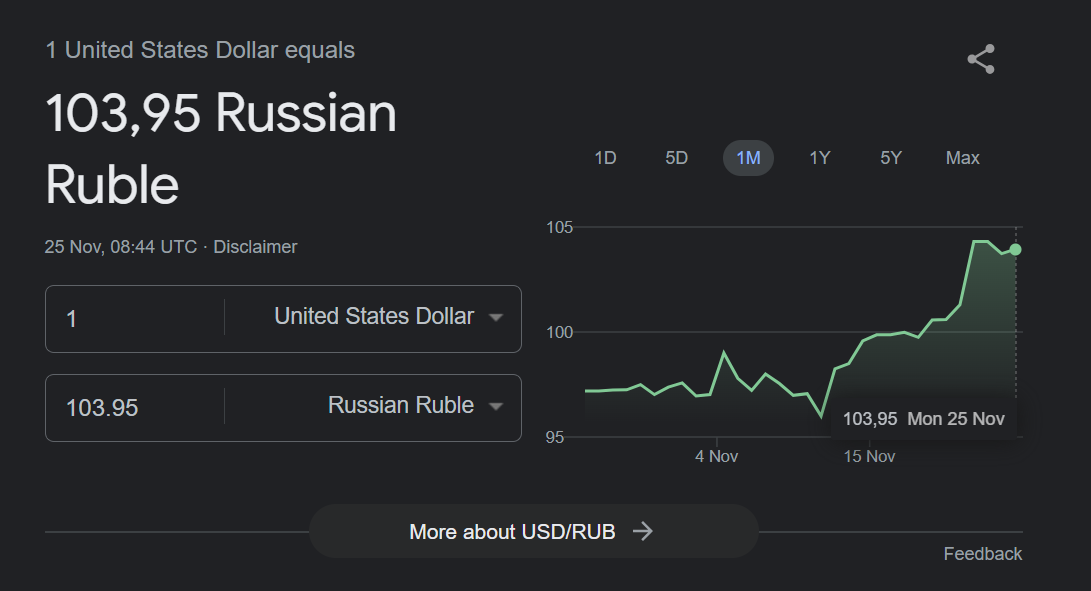Lost — the Plot. If you find it, please return it to the Kremlin
From The Moscow Times: “Some Muscovites are turning to armed robbery to obtain such a basic good as prices soar beyond the reach of many.”
There is one skill I’ve been trying to develop over the last two years: writing simple, short sentences that effectively deliver a message. Sometimes I succeed, but most of the time, I don’t. However, The Moscow Times nailed it in their recent story about the Russian economy.
Inflation is being driven not by standard market dynamics but by relentless wartime spending that is pushing the economy to the brink.
The price of butter in Russia has surged by 30% this year. Potatoes are up by 56%. Eggs are in short supply. Russia is now importing essential food items from Iran, India, and Turkey. Payments for North Korean troop support were made with S-400 air-defense systems.
Money is so scarce that Moscow seems to have regressed to an era before currency existed. It was the Mesopotamians who first used silver as money; before that, people bartered — exchanging goods and services for other goods and services. That’s where Moscow appears to be now.
The Kremlin won’t reveal the true inflation figures. But when thieves find it worthwhile to steal butter for resale, it’s a clear sign that inflation has spiraled out of control.
Butter prices in Russia have skyrocketed, sparking a wave of supermarket thefts as inflation accelerates amid the highest interest rates in 20 years.
Some Muscovites are turning to armed robbery to obtain such a basic good as prices soar beyond the reach of many. Surveillance footage dated Oct. 29 from a Pyaterochka supermarket on Leningradskoye highway captured two men attempting to steal 25 packs of butter. As they tried to escape, a scuffle broke out at the store’s exit: one robber struck a store assistant repeatedly, while the other threatened her with a knife.
According to reports on Telegram, thieves aren’t stealing butter for personal use but to resell it. Dozens of these packages have been spotted for sale at metro stalls or listed on dedicated social media channels.
How is Moscow trying to contain this?
Persistent inflation is not something that can be fixed in a short timeframe. It requires significant time and effort. Even a roaring U.S. economy, firing on all cylinders, took four years to bring inflation under control. The U.S. managed to escape the worst of COVID-era inflation because the economy added $8 trillion to its topline, enabling the Federal Reserve to raise interest rates and soften core inflation. In contrast, Europe is still struggling to tame inflation because its economy hasn’t grown at the same pace as the U.S.
Putin’s challenge is that Russia’s economy has stagnated. Productivity is beginning to decline, as the state has already maximized its investments in the defense industry. Russia is now in a recession, with inflation compounding the problem. The workforce continues to shrink.
In desperation, Russia has resorted to trading oil and weapons in exchange for essential goods from Iran, India, and Turkey. It’s surprising that China hasn’t joined this trade network yet — perhaps they demanded a higher markup on imports. That remains unclear.
Over the last two years, many of my readers have asked me when Russia will face economic collapse. I didn’t mention inflation. I didn’t point to wartime spending. I didn’t focus on crude oil exports or sanctions. Instead, I always told them that the first sign of panic would come from the ruble.
Why?
The ruble’s value plummets when economic conditions deteriorate. If the drop is sharp and noticeable, it indicates serious trouble. Once this shock occurs, and if Russia is still at war, it will ignite an inflationary spiral. That’s when the economy enters collapse territory.
We’re there now.
The ruble’s decline has slowed in the past few hours, but global markets haven’t fully opened yet. We need to see where it stands at the close of Monday’s trading. Still, the currency has lost more than 7% of its value over the last three weeks — a troubling sign.
They need to spend more rubles to import essential goods from other countries. If Putin is paying for these imports by sending barrels of crude oil, he now has to send more oil than he did a month ago to cover the same costs. This strategy reduces his top-line revenue, further exacerbating economic contraction.
Essentially, what’s happening now is that in an effort to control inflation, Putin is accelerating the contraction of Russia’s economy. The Kremlin has managed to delay the economic crisis by kicking the can down the road for months, but that runway has finally come to an end.
The potential lifting of sanctions by the Trump administration will do little to help Putin. Moscow’s core problem isn’t the dollar value of their daily revenue. It’s the relentless wartime spending and the ongoing depletion of Russia’s workforce.
For Ukraine, the key to winning the war from this point is simple: hold the line and refuse to surrender at the negotiation table. There’s no need to take the fight directly into Russian territory. No need to target refineries, crude oil facilities, or other economic assets. Instead, they should shift to an active defense strategy — a full-blown, entrenched, dogged defense.
Mobile defense strategies should be set aside in favor of fortifications.
Just hold the front line. Fortify air defenses. Dig in. Hold the line. Repeat.
Angry, disillusioned Russians will ultimately secure Ukraine’s victory. President Zelensky must remind Ukrainians just how close they are to turning the tide. For some reason — perhaps exhaustion — he hasn’t done enough to inform his countrymen about the dire state of the Russian economy and how crucial it is for them to hold on.
He needs to address this. And he needs to do it now.






Thank you for this article. It has really given me hope.
Hope. This is a great thing. Thank you for the detailed exposition. I knew of the various pieces, but wasn’t sure of their sum total.